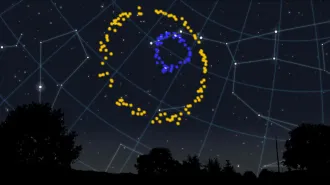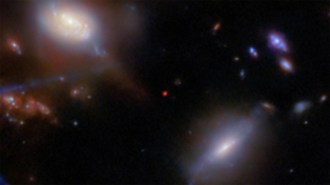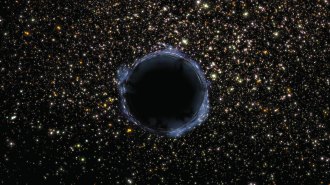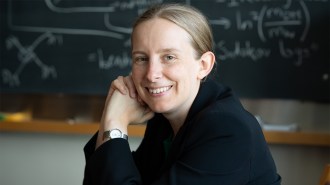
In ancient Greece, Aristotle deduced the existence of an exotic form of matter in space based on the circular symmetry of celestial motion, a symmetry preserved in the Ptolemaic model of planets orbiting the Earth in a combination of circular motions.
Andreas Cellarius/Wikimedia Commons
Second of two parts
Physicists have a lot in common with Ponce de León and U2’s Bono. After decades of searching, they aren’t getting any younger. And they still haven’t found what they’re looking for.
In this case, the object of the physicists’ quest is SUSY. SUSY is not a real person or even a fountain relevant to aging in any way. It’s a mathematical framework based on principles of symmetry that could help physicists better explain the mysteries of the universe. Many experts believe that particles predicted by SUSY are the weakly interacting massive particles, or WIMPs, that supposedly make up the invisible “dark matter” lurking throughout the cosmos.
So far, though, SUSY has been something of a disappointment. Despite multiple heroic searches, SUSY has remained concealed from view. Maybe it is a mathematical mirage.
If SUSY does turn out to be a myth, it won’t be the first time that symmetry has led science on a wild WIMP chase. Reasoning from the symmetry of circular motion originally suggested the existence of a new form of matter out in space more than two millennia ago. Devotion to that symmetry blinded science to the true nature of the solar system and planetary motion for the next 19 centuries.
You can blame Plato and Aristotle. In their day, ordinary matter supposedly consisted of four elements: earth, air, fire and water. Aristotle built an elaborate theory of motion based on those elements. He insisted that they naturally moved in straight lines; earth and water moving straight down (toward the center of the world), air and fire moving straight up. In the heavens, though, Aristotle noticed that motion appeared to be circular, as the stars rotated around the nighttime sky. “Our eyes tell us that the heavens revolve in a circle,” he wrote in On the Heavens. Since the known four elements all moved in a straight line, Aristotle deduced that the heavens must consist of a fifth element, called aether — absent on Earth but predominant in space.
Sign up for our newsletter
We summarize the week's scientific breakthroughs every Thursday.
Plato, on theoretical rather than observational grounds, had already insisted that circularity’s symmetry signified perfection, and therefore circular motion should be required in the heavens. And so for centuries, the assumption that celestial motion must be circular held a stranglehold on natural philosophers attempting to understand of the universe. As late as the 16th century, Copernicus was willing to depose Aristotle’s Earth from the middle of everything but still believed that the Earth and other planets revolved around the sun with a combination of circular motions. Another half century passed before Kepler established that planetary orbits are elliptical, not circular.
Aristotle’s belief in an exotic form of matter in space is not so different from the picture scientists paint of the heavens today, albeit in a rather more rigorous and sophisticated theoretical way. Dark matter predominates in space, astronomers believe; it is inferred to exist from gravitational effects altering the motions of stars and galaxies. And physicists have determined that the dark matter cannot (for various noncircular reasons) be made of the same ordinary matter found on Earth.
SUSY particles have long been one of the most popular proposals for the identity of this cosmic dark matter, based on more complicated notions of symmetry than those available to Plato and Aristotle. And since the onset of the 20th century, symmetry math has generated an astounding string of scientific successes. From Einstein’s relativity to the theory of elementary particles and forces, symmetry considerations now form the core of science’s understanding of nature.
These mathematical forms of symmetry are more elaborate examples of symmetry as commonly understood: a change that leaves things looking like they did before. A perfectly symmetric face looks the same when a mirror swaps left with right. A perfect sphere’s appearance is not altered when you rotate it to see the other side. Rotate a snowflake by any multiple of 60 degrees and you see the same snowflake.
In a similar way, more sophisticated mathematical frameworks, known as symmetry groups, describe aspects of the physical world, such as time and space or the families of subatomic particles that make up matter or transmit forces. Symmetries in the equations of such math can even predict previously unknown phenomena. Symmetry in the equations describing subatomic particles, for instance, revealed that for each particle nature allowed an antimatter particle, with opposite electric charge.
In fact, all the known ordinary matter and force particles fit neatly into the mathematical patterns described by symmetry groups. But none of those particles can explain the dark matter.
SUSY particles as a dark matter possibility emerged in the 1970s and 1980s, when theorists proposed an even more advanced symmetry system. That math, called supersymmetry (hence SUSY), suggested the existence of a “super” partner particle for each known particle: a force-particle partner for every matter particle, and a matter-particle partner for every force particle. It was an elegant concept mathematically, and it solved (or at least ameliorated) some other vexing theoretical problems. Plus, of the super partner particles it predicted, the lightest one (whichever one that was) seemed likely to be a perfect dark matter WIMP.
Alas, efforts to detect WIMPs (which should be hitting the Earth all the time) have almost all failed to find any. One experiment that did claim a WIMP detection seems to be on shaky ground — a new experiment, using the same method and materials, reports no such WIMP evidence. And attempts to produce SUSY particles in the world’s most powerful particle accelerator, the Large Hadron Collider, have also come up empty.
Some physicists have therefore given up on SUSY. And perhaps supersymmetry has been as misleading as the Greek infatuation with circular motion. But the truth is that SUSY is not a theory that can be slain by a single experiment. It is a more nebulous mathematical notion, a framework within which many specific theories can be constructed.
“You can’t really kill SUSY because it’s not a thing,” physicist Patrick Stengel of the International Higher School of Advanced Studies in Trieste, Italy, said at a conference in Washington, D.C., in 2019. “It’s not an idea that you can kill. It’s basically just a framework for a bunch of ideas.”
At the same conference, University of Texas at Austin physicist Katherine Freese pointed out that there was never any guarantee that the Large Hadron Collider would discover SUSY. “Even before the LHC got built, there were a lot of people who said, well, it might not go to a high enough energy,” she said.
So SUSY may yet turn out to be an example of symmetry that leads physics to success. But just in case, physicists have pursued other dark matter possibilities. One old suggestion that has recently received renewed interest is a lightweight hypothetical particle called an axion (SN: 3/24/20).
Of course, if axions do exist, symmetry fans could still rejoice — the motivation for proposing the axion to begin with was resolving an issue with yet another form of symmetry.








